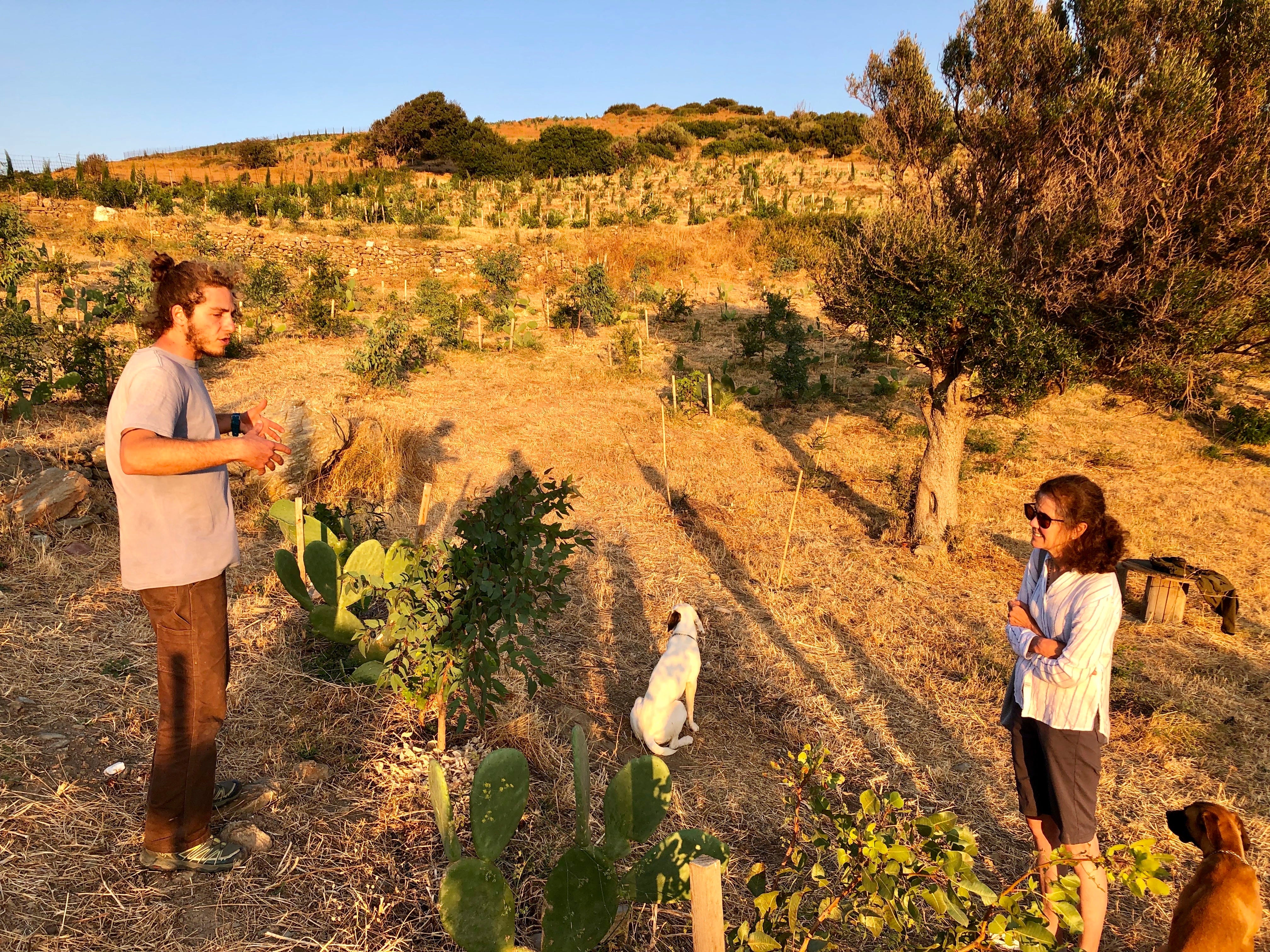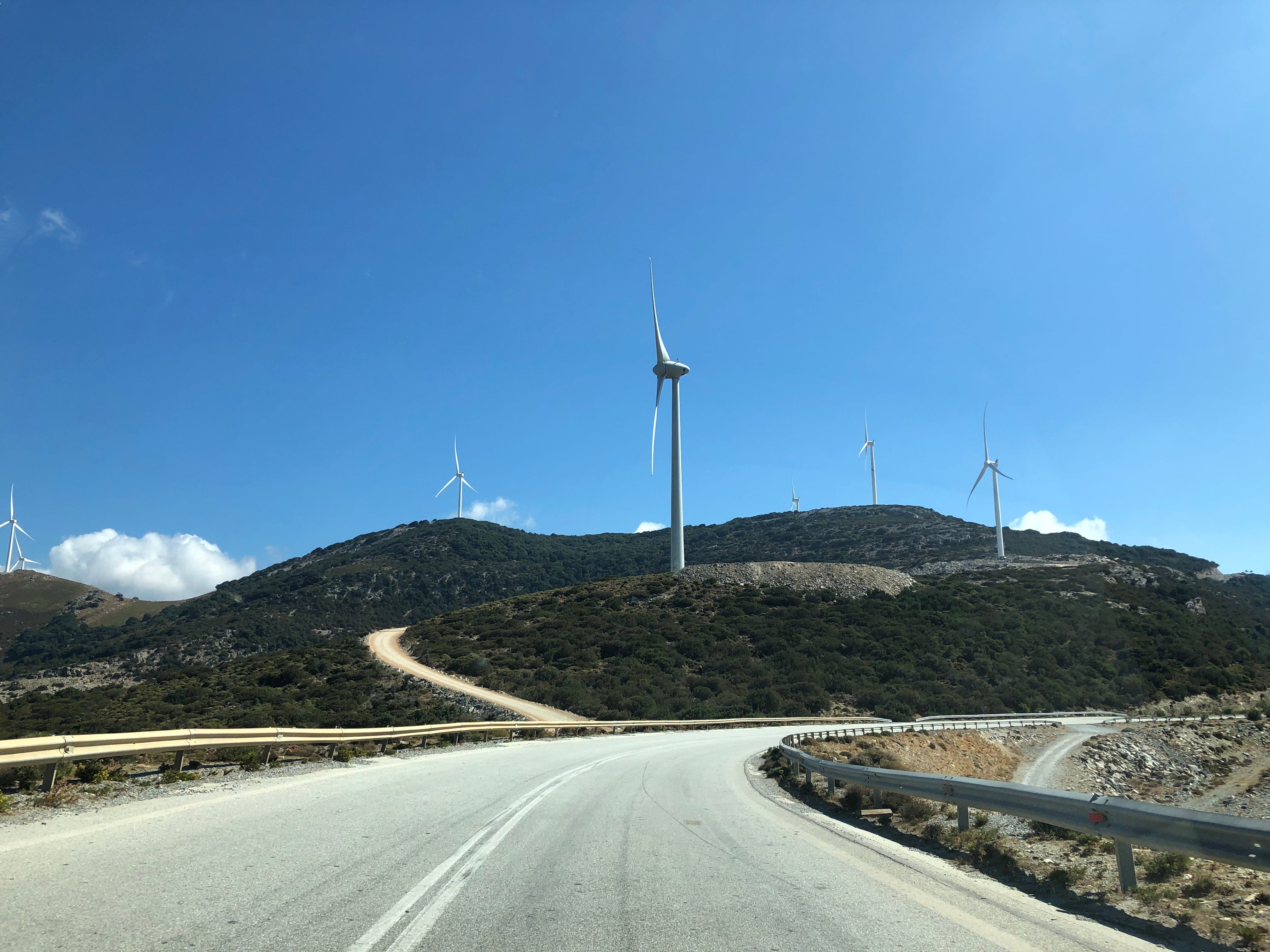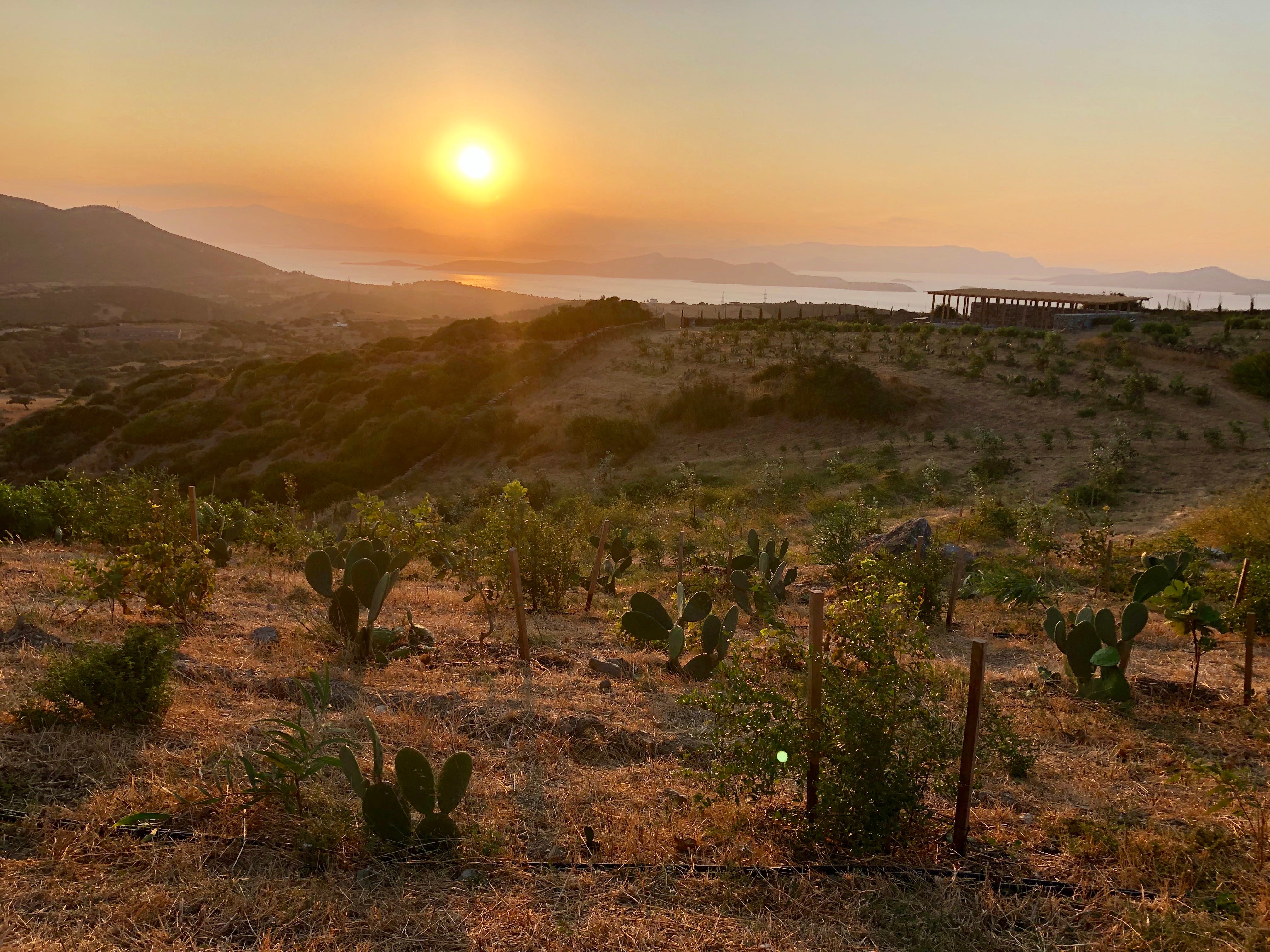 Dimitri Tsitos and Diana Donlon on Mazi Farm, a regenerative farm in Greece. (photos by Warren Karlenzig)
Dimitri Tsitos and Diana Donlon on Mazi Farm, a regenerative farm in Greece. (photos by Warren Karlenzig)
Dimitri Tsitos meets us in Styra, a village mentioned by Homer in the Iliad in the 8th century BC. Tall, blonde and wise beyond his 25 years, Dimitri is the founder of Mazi Farm, a regenerative farm featured on Soil Centric’s new recommendation tool. The town square is eerily silent. As we walk back to the rental car we’d ditched on the outskirts of town, he offers Warren, my
partner, and me each a section of freshly picked yellowish-pink pomegranate to sample. The translucent seeds are dripping with juice and the flavor is subtle and sweet and bears little resemblance to the tart crimson orbs we get at home. Eating an iconic fruit that figures prominently in Greek mythology while walking along a marble path bathed in crepuscular light, I feel enveloped by the enormity of Greek history.
Mazi Farm is a short way up the same ridge from the village. Dimitri bought the stark five-hectare hilltop parcel with his parents in 2017. The rolling terrain has a stunning, unobstructed view of the Aegean Sea below, but the soil is obviously degraded and there is almost no infrastructure save a large pergola for shade. “We have water” says Dimitri cheerfully “and
gravity-fed irrigation, but no electricity. Right now, the view is the best thing we have going for us.”
Mazi means “together” in Greek and so far, Dimitri and a team of volunteers including family and university friends, have planted 8,000 trees: almond, fig, pistachio, prickly pear cactus, and yes, pomegranate, together. Eucalyptus, cypress, acacia and other fast-growing species are planted like sentries between the fruit and nut trees to protect the saplings from the now-barren island’spunishing conditions. “Evia Island is incredibly windy” Dimitri tells us. It’s hard not to notice the giant wind turbines spinning along the island’s spine.

Wind Turbines on the Island of Evia
Directly across the Aegean from Athens and the Greek mainland, Evia is the second largest island in Greece. For much of its modern history it has existed to provide natural resources for the capital’s metropolitan region of just under 4 million. The majestic oaks that characterize the neighboring island of Kea are largely absent as are the tourists that flock to other islands. It is the end of September, and like much of California’s agricultural land, it is hot, brown, dry and increasingly menaced by fire. We walk along the rolling slopes and Dimitri is excited to show us patches of earth where perennials plants are starting to pop-up even before the first rains have started. “With their deep and powerful roots,” he explains that “these native perennials have potential to de-compact soil on the farm.” Photosynthesis drives the system by taking light energy and converting it into biochemical energy resulting in more life above and below ground. The young plants transpire moisture and have a cooling effect on the ambient temperature. Leaves, stems and flowers provide habitat for insects, birds and other creatures as well as food for pollinators. In time they will provide food for humans and an income stream for the fledgling farm.
As a university student, Dimitri was overcome by climate anxiety and moved to South America where he thought hard about what he really wanted to do with his life. When the opportunity to apprentice with the legendary Ernst Götsch in Brazil presented itself, he seized it. Götsch, who grew up in a Swiss farming family before moving to Brazil in 1976, favors a form of regeneration based on syntropic farming and agroforestry. Using nature as his model, he follows the laws of syntropy where, contrary to entropy, more energy in generated in a natural system than has been invested. Agroforestry is the intentional integration of trees and shrubs into crop and animal farming systems to create environmental, economic, and social benefits; Within this system Götsch is particularly known for his heavy pruning-to-mulching technique known as “chop and drop.” Applying these principles in the tropics produces jaw-dropping results. Götsch has personally regenerated 500 hectares (1,200 acres) of degraded land in Brazil’s Atlantic Rainforest. Working at Götsch’s side, Dimitri learned to heal the land and his climate anxiety.
Inspired by what he experienced in Brazil, Dimitri returned to Europe and convinced his Greek father and French mother to move from the city (Athens) to the countryside (Styra) and help him create a working model of regeneration for the Mediterranean. The new farm would draw largely
on principles he’d learned from Götsch.
In addition to planting 8,000 trees, Dimitri has also hosted Meet Ups in Athens, launched a successful crowd-funding campaign, built the large pergola and, this past August, hosted a team of international volunteers who harvested and then dried figs; A neighboring organic farm was looking for help during the harvest and invited Mazi to collaborate with them.
After a spectacular sunset, Warren, Dimitri and I go back to the village square to eat a freshly prepared feast at a table outside under the stars. The village has come to life and the food is the best we’ve had anywhere in Greece. Dimitri tells us that until the 1980s Styra was a thriving agricultural community. He says the old timers tell him that farming used to be so much easier: “They’d plant tomatoes, eggplant, garlic. They would get a good harvest and would sell it at the weekly market.” Government policies helped to encourage an urban exodus. They built New Styra a no-frills government-backed seaside resort town a few kilometers downhill. Today only a
few hundred people live in the original village and the young are largely absent. As a young farmer new to Styra, Dimitri is something of a curiosity and a celebrity.
As we tuck into plates of fava bean hummus and tzatziki we talk about everything: his immediate needs to make his farm economically viable, perhaps getting laying hens to fertilize the land and produce eggs that could be sold in the village, ways to lure young people back to agrarian life, and the exciting possibility of regenerating large parts of the globe for food, water and climate security.
As a beginning farmer, Dimitri realizes he lacks access to inter-generational knowledge and would love a mentor he can call weekly to talk about what’s happening on the land. This in turn would help him set up “smart and regenerative systems.” He’d like access to serious interns and volunteers. He thinks long term about systems that create opportunities for farmers to transition to or start regenerative farms. We discuss how my organization, Soil Centric, can help connect him to these resources.
The postmaster walks up to our table and hands Dimitri a package. It’s a book he’s ordered. When he’s not in the field, he’s hungrily reading everything he can about regeneration, soil, farming, agroforestry, holistic management, permaculture and design. He’s connecting with the regenerative community around the world and pouring his youthful energy into realizing the
positive, syntropic feedback loop that is his vision for Mazi Farm. Situated as it is in the cradle of Western Civilization, where everything is both ancient and very new, I can think of no better place to create a farm for the future.
 Sunset at Mazi Farm above the ancient Greek village of Styra.
Sunset at Mazi Farm above the ancient Greek village of Styra.
